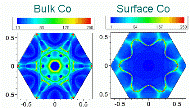Department of Physics and Astronomy: Publications and Other Research
Date of this Version
7-15-1993
Abstract
A symmetry analysis of the contributions to the transition operator from vibronic coupling provides symmetry selection rules for vibrational excitation by resonant electron impact in polyatomic molecules. In the context of electron scattering vibronic coupling operates in two modes. These are named internal and external vibronic coupling. Internal vibronic coupling operates within and among the quasibound states giving rise to the resonances. External vibronic coupling operates between the quasibound states and the continuum. We discuss the differences, particularly with respect to the angular distribution of electron scattering. A complete symmetry analysis of vibrational excitation is given using benzene as an example. The Journal of Chemical Physics is copyrighted by The American Institute of Physics.


Comments
Published by American Institute of Physics. J. Chem. Phys. 99, 827 (1993). ©1993 American Institute of Physics. Permission to use. http://jcp.aip.org/.